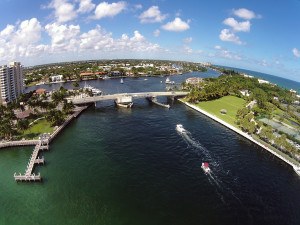Since eight hurricanes whipped through Florida during back-to-back seasons a decade ago, causing $33 billion in insurance claims, the state’s coastal communities have added an additional 1.5 million people and almost a half-million new houses, an Associated Press analysis shows.
But experts say the risk of catastrophic destruction hasn’t grown along with the new development because Florida builders are doing a better job of making structures hurricane-resistant.

The improvement derives from Florida’s statewide building code, which was implemented in 2002, a decade after Hurricane Andrew’s 165-mph winds gutted parts of South Florida. The code means that all new structures get tough inspections and are built with shatter-proof glass and straps reinforcing the connection between roof and walls.
More than two-thirds of Florida’s almost 20 million residents live in coastal counties.
“The building code changes have made a huge difference,” said Shahid Hamid, a professor at the International Hurricane Research Center at Florida International University. “You have more houses being built, and that certainly means more exposure and losses will go up, but on the other hand, the houses that are more recently built are better built and can perform better in hurricanes.”
The stronger building standards haven’t translated into reduced insurance premiums. Florida homeowners still pay about twice the national average for insurance, and rates in the Sunshine State are still the most expensive in the nation.
As the Atlantic hurricane season opens Monday, here is a look at two Florida regions that have seen tremendous growth since the busy 2004 and 2005 seasons.
SOUTH FLORIDA
The three counties that make up South Florida – Broward, Miami-Dade and Palm Beach – account for more than half of the $337 billion increase in property values along Florida’s coast in the last decade. The values of all properties in Florida’s coastal counties reached $1.5 trillion last year, according to AP calculations based on Florida Department of Revenue data.
Parks have been added between buildings and Biscayne Bay in Miami. The green spaces appeal to luxury home buyers looking for urban amenities within walking distance, but they also act as buffers against storm surge, said Carlos Rosso, whose Miami-based development company has built gleaming, waterfront condominium towers from Miami to Fort Lauderdale in recent years.
“We are trying to create a little more conscientiousness about it,” said Rosso, president of the condominium division of The Related Group.
The new buildings have largely empty ground floors in case of flooding and residences constructed on floors well above storm surge projections. They’re also equipped with emergency generators and shatter-proof glass windows, all meant to minimize damage from even the worst of storms.
PANHANDLE
Developers have built a secluded string of beach communities lined with multimillion-dollar residences between the high-rise condominiums, chain restaurants and miniature golf courses from Destin in the west and Panama City in the east. The beach communities known as 30A for the road that winds through them have become home to well-known politicians, professional athletes and Nashville recording stars.
Property values in the two counties that stretch between Destin and Panama City – Bay and Walton counties – have jumped by more than 50 percent as a result.
Along the far southern coastal part of Walton County, where homes sell for seven figures, real estate development is now worth $13 billion, said Walton County Commissioner Cindy Meadows.
“We are seeing a different sort of house,” Meadows said. “Most use concrete piling and all of the latest hurricane reinforcements.”
Homeowners paying $3 million or more for a vacation home understand the risk of investing in an area where hurricanes can strike, and the strengthened building codes provide confidence that the structures can withstand high-intensity storms, said Scott Kurfirst, co-founder of Coastal Elements Construction, which builds beachfront mansions.
Builders use straps reinforcing the connection between roof and walls throughout the homes and a lot of reinforced concrete, he said.
“It isn’t a huge concern that buyers talk about,” Kurfirst said. “The structures are incredibly solid.”
(Schneider reported from Orlando. Nelson reported from Pensacola.)
Was this article valuable?
Here are more articles you may enjoy.


 NYC Sues Delivery App Over Lost Pay in New Mamdani Crackdown
NYC Sues Delivery App Over Lost Pay in New Mamdani Crackdown  The Return Period for An LA Wildfire-Scale Event May Be Shorter Than You Think
The Return Period for An LA Wildfire-Scale Event May Be Shorter Than You Think  What The Return of California’s ‘Death Discount’ Means for Litigation
What The Return of California’s ‘Death Discount’ Means for Litigation  Singer’s Elliott Sued by PE Firm in Escalating Fight Over Money
Singer’s Elliott Sued by PE Firm in Escalating Fight Over Money 